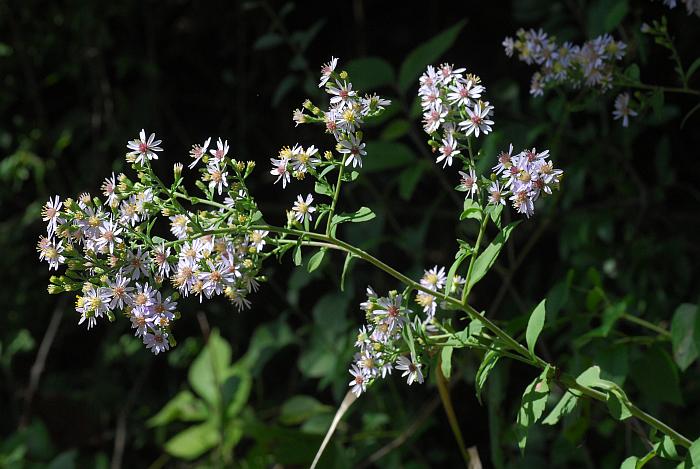Symphyotrichum cordifolium (L.) G.L. Nesom
Blue Wood Aster

Native
CC = 7
CW = 5
MOC = 55
© SRTurner
Symphyotrichum cordifolium (L.) G.L. NesomBlue Wood Aster | |
 |
Native CC = 7 CW = 5 MOC = 55 |
© SRTurner |
|
Family - Asteraceae/Astereae Habit - Perennial herbs, usually from a short, stout, sometimes woody rootstock, often also producing elongate rhizomes. Stems - Arched to ascending, to 1.2 m, unbranched or with ascending branches above the midpoint, glabrous or sparsely to moderately pubescent toward the tip with short, curled hairs in longitudinal lines or bands.
Leaves - Basal and lower stem leaves usually present at flowering, long-petiolate, the petiole unwinged or very narrowly winged, the blade to cm long, 1-6 cm wide, heart-shaped, deeply cordate at the base, sharply pointed, the margins sharply and often relatively coarsely toothed, glabrous or sparsely roughened on the upper surface, sparsely to moderately pubescent, mostly along the veins, on the undersurface, the secondary veins on the undersurface usually easily observed, often irregularly fused toward their tips, the faint veinlets forming a dense, irregular network of relatively short areoles. Median and upper stem leaves reduced upward, with mostly long, unwinged to narrowly winged, nonclasping but somewhat sheathing petioles, the blades 1-7 cm long, lanceolate to ovate, cordate to short-tapered at the base, otherwise similar to the lower stem leaves.
Inflorescence - Panicles usually with relatively long, loosely ascending, racemose branches, the bracts along the ultimate branches 0.3-1.2 cm long, leaflike, linear, noticeably to only somewhat shorter and narrower than the adjacent foliage leaves.
Heads - Flowering heads mostly 1-2 cm in diameter. Involucre 3.5-5.5 mm long, the bracts in 4-6 unequal, overlapping series. Involucral bracts linear, bluntly to sharply pointed or with an abrupt, short, sharp point at the tip, the tip erect or ascending (the lowermost bracts occasionally slightly spreading), the slender midvein broadened in the apical 1/4-1/2 into a well-defined, diamond-shaped or elliptic, green area, the outer surface usually glabrous or nearly so, the margins irregularly hairy, especially toward the tip.
Florets - Ray florets 8-15, usually in 1 series, the corollas well developed, 6-12 mm long, lavender. Disc florets 12-20, the corollas 3.5-5.0 mm long, the slender portion of the tube shorter than the slightly expanded apical portion, the lobes 0.6- 0.9 mm long, 20-25 percent of the total length of the expanded portion. Pappus bristles 3-5 mm long, light tan.
Fruits - 1.5-2.5 mm long, with 4 longitudinal ribs, purplish brown to brown, often with lighter ribs, glabrous or sparsely hairy. Flowering - August - November. Habitat - Forests, streambanks, bluffs. Origin - Native to the U.S. Lookalikes - Other fall asters, especially S. drummondii. Other info. - This is one of a few late summer to fall blooming asters having arrowhead-shaped lower leaves and light purple ray florets. It can be difficult to distinguish from S. drummondii, differing from that species in having very narrow wings, at most, along the lower leaf petioles. The green markings on the involucral bracts are typically well-defined and stand out against the paler green of the involucre. The plant is found throughout most of Missouri, though much more commonly in the eastern half, as well as the eastern half of the continental U.S. Its range westward ends rather abruptly along a longitude corresponding roughly to the western boundary of Missouri. Photographs taken along the Katy Trail in St. Charles County, 10-1-2015, and at Catawissa Conservation Area, Franklin County, MO, 9-26-2018 (SRTurner). |